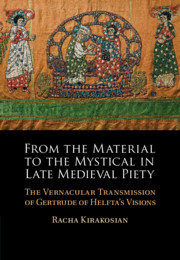 From the Material to the Mystical in Late Medieval Piety
From the Material to the Mystical in Late Medieval Piety Published online by Cambridge University Press: 01 September 2021
The visions of Gertrude of Helfta have been said to exhibit ‘[v]irtually all the vestments that are deployed in the various forms of monastic liturgies’.1 In one of Gertrude’s visions, on Easter Monday, the transforming image of a dress charts a dizzying superimposition of liturgical celebration and textile culture. The imagery derives from a phenomenological spectrum which evokes knowledge of medieval handicraft and visual traditions. Imaginary textiles build upon a material culture in which devotion and craftmanship go hand in hand.2 Exegetical notions of textiles such as Birgitta of Sweden’s understanding of Scripture as clothing – ‘Law is like clothing’3 – come into play when considering visionary textiles. Descriptions of women’s clothing offer us the possibility to understand the self-image of medieval religious women.4 In the study of textile images in the botte, various aspects of textile imagery – visibility, performativity, craftsmanship, and imperfection necessitating transformation – come together, underlining the intricate interlacing of material and devotional cultures. Mapping between historical textiles, medieval allegories such as Alan of Lille’s twelfth-century prosimetrum De planctu naturae, and Gertrude’s Easter Monday vision, I show how in the botte material aspects and immaterial concepts merge into a powerful narrative about vision and salvation, and how the botte exploits vernacular language to the advantage of a mystically orientated textile culture.
To save this book to your Kindle, first ensure [email protected] is added to your Approved Personal Document E-mail List under your Personal Document Settings on the Manage Your Content and Devices page of your Amazon account. Then enter the ‘name’ part of your Kindle email address below. Find out more about saving to your Kindle.
Note you can select to save to either the @free.kindle.com or @kindle.com variations. ‘@free.kindle.com’ emails are free but can only be saved to your device when it is connected to wi-fi. ‘@kindle.com’ emails can be delivered even when you are not connected to wi-fi, but note that service fees apply.
Find out more about the Kindle Personal Document Service.
To save content items to your account, please confirm that you agree to abide by our usage policies. If this is the first time you use this feature, you will be asked to authorise Cambridge Core to connect with your account. Find out more about saving content to Dropbox.
To save content items to your account, please confirm that you agree to abide by our usage policies. If this is the first time you use this feature, you will be asked to authorise Cambridge Core to connect with your account. Find out more about saving content to Google Drive.